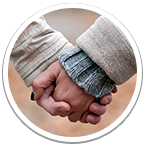Neighbourhood work
The background and need for community-based neighbourhood work
Over the past ten years, there has been an increase in drug use and related harms in Finland. Drug use may be visible in urban spaces as the illicit sales, and use of drugs are visible and may cause harms and side effects, such as public disturbances, littering, and unpleasant or messy environments.
Near housing and substance use services or low-threshold services gathering of people who use drugs may increase various side effects and harms in the neighbourhood. For example, residents often feel unsafe in places where people who use drugs gather and spend their time. In addition, local residents may feel concerned, opposed and fearful of services aimed at people who use drugs and the establishment of new services for them. This makes it important to listen and respond to the concerns of everyone involved in the neighbourhood and region.
The side effects and harms caused by substance use and safety concerns experienced by local residents can be influenced by active multi-actor cooperation with the police, community outreach work, substance use services, and housing service providers, as well as with people who use services and the entire neighbourhood. This sort of collaboration is referred to as community-based neighbourhood work.
The aim of neighbourhood work is that:
- the environment will remain comfortable and safe for everyone involved.
- the negative stigma (negative attitudes and prejudices) on people who use drugs and their services will be reduced.
- people will accept people who use drugs and persons in recovery as well as their services in their neighbourhoods and areas.
- people who use drugs feel like a part of the community and neighbourhood.
How is neighbourhood work carried out?
Neighbourhood work focuses on practical solutions and is always built on local needs. Systematic and regular neighbourhood work should be integrated into certain services as a regular approach. These services include, in particular, housing services (housing first units and services for homeless people), opioid agonist treatment services, health counselling for people who use drugs and other low-threshold services, such as day centres and, in the future, possibly also supervised injection sites.
Methods
Responding to feedback
The providers of the above services should create a feedback channel for residents and provide information about this in the neighbourhood. Potential feedback channels can include a contact form on the service provider’s website, telephone number, email or WhatsApp number.
Neighbourhood walks
Substance use or housing service workers engage in through systematic and regular outreach work in the local environment, streets, parks and areas where the side effects and harms of substance abuse occur.
The work includes encounters with neighbours and responding to neighbours’ concerns as well as the prevention of potential problems and conflicts, such as guiding people who use drugs to take other people into consideration. In addition, a mediating approach is used to intervene in disturbing behaviour and problems.
For example, the workers clean up drug paraphernalia and other litter from the environment. However, the work goes beyond collecting litter; the aim is to be visible and available, to respond to neighbours’ concerns, answer their questions and intervene in public disturbances and prevent conflict situations through neighbourhood presence.
The neighbourhood workers can also go around local shops or other business premises in the area to discuss and solve possible problems or disturbances supporting shoplifting investigations. As a result, the approach has also succeeded in preventing and investigating shoplifting.
Paying minor compensation for people who use drugs to carry out neighbourhood work (e.g. collecting used syringes and litter) can prevent the need for them to commit property crimes.
Community events
- Open days
- Neighbourhood forums: regular discussion events open to everyone, to which neighbours, entrepreneurs and different operators from the neighbourhood are invited
- Client forums organised with service users
- Training events, campaigns, communications
- Volunteer work, litter removal campaigns, garden events, etc.
Partners
Neighbourhood work can be planned, developed and implemented according to the local needs by bringing together a network whose members may include:
- Police
- Those involved in outreach work
- Others involved in the services for people who use drugs and homeless people locally
- People with insight through personal experience, peer workers
- Resident associations, housing companies, local residents
- Parent associations, schools, day-care centres
- Entrepreneurs and shopkeepers
- Other local operators
- Different representatives of the municipality and region
Example of local cooperation
The new multidisciplinary and coordinated working approach developed in Helsinki for neighbourhood work is used to reduce prejudice against people who use drugs and support them in seeking services. The neighbourhood work model was developed in cooperation with experts in substance abuse and other fields, the police and local residents in 2022. The model is currently being piloted in the Kurvi area in Sörnäinen. The Kurvi working group offers people in the neighbourhood an opportunity to contact, ask for advice, request support and participate in managing shared in the neighbourhood to promote safety and comfort.




